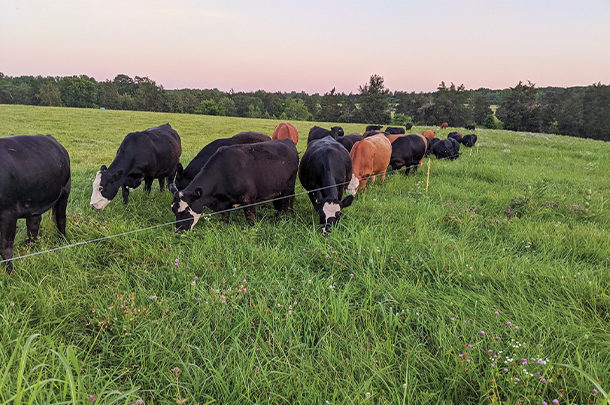Managed rotational grazing in some form goes back to the domestication of livestock. The rotational grazing system may be implemented in various ways, ranging from movement through many permanent paddocks, to herding on open range. Graziers spend a lot of time discussing the various practices and tools needed to follow the simple principle, and many spend their whole lifetime developing their own unique take on the basic concept.
While this approach is still not the norm for the livestock industry in most of the country, there is clearly increasing adoption of managed grazing. In recent years, we have seen a surge in interest in the Amazing Grazing program as a result of the soil health movement. It is now recognized that poor grazing management, and especially overgrazing, is detrimental to soil health, water infiltration, forage yield and water quality. Many farmers are starting to manage with a more ecological approach, managing to benefit the many aspects of the system in addition to livestock. Creating a healthy pasture ecosystem will take a number of years, but as the system comes into balance, you will see many benefits.
There are many “systems” of grazing management. The first I was exposed to happened to be the “Savory System,” introduced in the 1960s in the western U.S. It was a blessing for some but a bust for others. In the 1990s, I met Jim Gerrish and became a student of management intensive grazing (MIG). We still use his books MIG, the Grass Roots of Grass Farming and Kick the Hay Habit as resources for our extension agents, as he has a great way of explaining the principles of grazing management. I also came across Greg Judy and read his book Comeback Farms. This was an interesting read, and while I didn’t agree with some points, I learned a lot about how to use temporary fencing in an adaptive management system.
At some point as I researched and experimented with various practices, I realized that adaptive management is not about following a system developed by someone else. If you understand the principles and then use your unique situation and resources as a guide, you can develop an approach that can be resilient to challenges both on the farm and in the rest of your life. Developing an approach that you can sustain over decades is a key goal.
In addition to working for NC Cooperative Extension, I also run 110 cows north of Raleigh on my family place in Southside, Virginia. Using a combination of permanent pastures and temporary internal subdivision is the system we have found works well for us. While I have managed the farm now for 30 years, I spent the spring and summer this year fine-tuning my grazing management skills. By making management decisions nearly every day, and then being observant and critically evaluating how I was doing, I learned a lot. That is adaptive management, and if you use it, you never stop learning.
We have a lot of power on our fence, so the cattle are very well-trained, and the benefits of that are obvious. When running late one day, I found I could move my lead wire by taking out all the posts and then pulling the fence along until I opened the size strip I wanted, and then walk back and put the posts back. It is similar to using tumble wheel posts to move the fence, but a lot less expensive. I got to where I could cut more than half the time off moving cows using this technique.
You would think cows would charge ahead and go over the wire, but they typically don’t, especially when there are seed heads to hold the wire up off the ground, and there is a lot of power on it. It works especially well when strip grazing heading ryegrass or fescue. I am calling this “sweep grazing,” and it is just another of the many practices you might (or might not) want to implement on your farm.
Probably the most important benefit for me of adaptive grazing management and temporary electric fence is how it impacts animal behavior. The benefits are seen in all species, but with cattle, they become very docile and adapted to close human contact. Cattle become trained to come to you and to walk closely by you, all of which makes them easier to deal with both in the pasture and working pen. Cows also learn you will regularly provide for them, so they are content to clean up what you have allocated them and will patiently wait for the next allocation.
One of the best things about adaptive management is that it is more a personalized management style than a system. You can start simple, and as you learn more you will implement some practices (and potentially abandon others) and eventually start to evolve a system that fits your management style. Read and learn all you can from others, but keep in mind that you need to create your own customized system rather than following someone else’s recipe exactly.
To learn more about how to adopt adaptive grazing management, search “twelve-step plan to Amazing Grazing” and “the power of one wire” online. ![]()
PHOTO: Cows strip graze fescue regrowth. Photo by Matt Poore.
Matt Poore is the director of the Amazing Grazing program.

-
Matt Poore
- Professor of Animal Science and Extension Beef Specialist
- North Carolina State University
- Email Matt Poore









